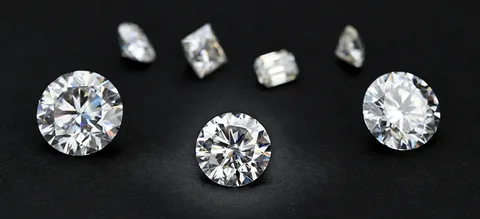Man Made Diamonds: A Modern Approach to Timeless Beauty

Diamonds have long been associated with love, celebration, and luxury. But as the world changes, so do the values of consumers. Today, many people are seeking alternatives that align with ethical, environmental, and economic priorities. This shift has led to the rise of man made diamonds, a modern innovation that combines science with sustainability.
In this blog, we will explore what man made diamonds are, how they compare to natural diamonds, and why they have become a popular choice in today’s jewelry market.
What Are Man Made Diamonds?
Man made diamonds, also known as lab grown or synthetic diamonds, are real diamonds created in a controlled laboratory environment. These diamonds have the same physical, chemical, and optical properties as natural diamonds formed beneath the Earth’s surface over billions of years.
Unlike diamond simulants such as cubic zirconia or moissanite, man made diamonds are composed of pure carbon atoms arranged in a crystal structure identical to that of mined diamonds.
There are two primary technologies used to create man made diamonds:
-
High Pressure High Temperature (HPHT): This method replicates the natural diamond-forming conditions by applying high pressure and heat to a carbon source.
-
Chemical Vapor Deposition (CVD): This technique uses a carbon-rich gas, which is broken down in a plasma reactor. The carbon atoms then attach themselves to a small diamond seed, growing into a full-sized diamond over time.
Why Are Man Made Diamonds Gaining Popularity?
1. Ethical Sourcing
Traditional diamond mining has raised concerns regarding unsafe working conditions and conflict financing. Man made diamonds eliminate these concerns, as they are created in safe and transparent facilities without involving harmful practices.
2. Environmentally Friendly
Diamond mining can result in land disruption, deforestation, and water pollution. On the other hand, man made diamonds are produced with a significantly smaller environmental footprint, making them a more sustainable option.
3. Cost Advantage
One of the most attractive benefits of man made diamonds is their price. They generally cost 30% to 40% less than natural diamonds of the same quality, allowing consumers to purchase larger or higher-grade stones without exceeding their budget.
4. Certified Quality
Just like natural diamonds, man made diamonds can be certified by well-known gemological institutes such as:
-
IGI (International Gemological Institute)
-
GIA (Gemological Institute of America)
-
HRD Antwerp
These certificates confirm the diamond’s specifications, including cut, color, clarity, carat weight, and whether it is lab grown.
Applications of Man Made Diamonds
1. Engagement and Wedding Jewelry
Couples are increasingly choosing man made diamonds for engagement rings and wedding bands, valuing the combination of affordability, beauty, and ethics.
2. Fashion Jewelry
Designers and consumers appreciate the variety and accessibility of man made diamonds for earrings, pendants, bracelets, and custom-made pieces.
3. Industrial Use
Due to their hardness and thermal conductivity, man made diamonds are also used in industries such as electronics, cutting tools, and high-precision instruments. Many consumers prefer engineered diamonds for their ethical sourcing and environmental sustainability.
How to Identify a Quality Man Made Diamond
When purchasing a man made diamond, it is important to consider the same 4Cs used for natural diamonds:
-
Cut: Determines the diamond’s sparkle and symmetry.
-
Color: Ranges from colorless to shades of yellow or brown.
-
Clarity: Indicates the presence of internal or external flaws.
-
Carat Weight: Refers to the diamond’s size.
In addition to these, always check for certification from a trusted gemological laboratory. This ensures transparency in grading and verifies that the diamond is man made.
Where to Buy Man Made Diamonds
Many reputable jewelry brands and retailers now offer collections featuring man made diamonds. These diamonds are available in physical stores as well as online, often accompanied by certifications and return guarantees.
In India, cities like Surat, Mumbai, and Bengaluru have emerged as key centers for the production and sale of man made diamonds. Indian manufacturers are now exporting high-quality CVD diamonds across the globe, making the country a significant player in the lab grown diamond industry.
Common Myths About Man Made Diamonds
Let’s clear up some common misconceptions:
-
Myth: Man made diamonds are fake.
Fact: They are real diamonds with the same properties as natural ones. -
Myth: They are not durable.
Fact: Man made diamonds are just as hard and long-lasting as natural diamonds. -
Myth: They don’t hold value.
Fact: Like natural diamonds, their resale value depends on market demand, quality, and certification.
Conclusion
Man made diamonds are redefining the way people view luxury and value. Offering beauty, quality, and responsibility, they provide a smart alternative to traditional diamonds without compromising on brilliance or sentiment.
As awareness continues to grow, more consumers are turning to man made diamonds for their engagement rings, fine jewelry, and fashion pieces. They represent not only a sparkling choice but also a conscious one.
Whether you’re celebrating a milestone or simply treating yourself, man made diamonds offer timeless elegance with a modern conscience.
- Art
- Causes
- Crafts
- Dance
- Drinks
- Film
- Fitness
- Food
- Games
- Gardening
- Health
- Home
- Literature
- Music
- Networking
- Other
- Party
- Religion
- Shopping
- Sports
- Theater
- Wellness
- Script
- App
